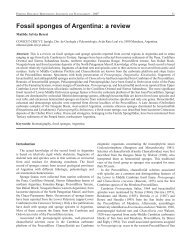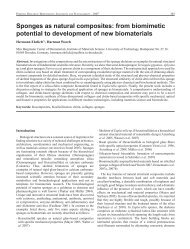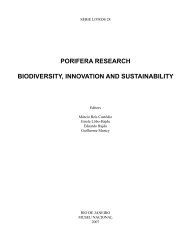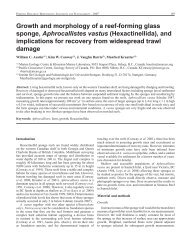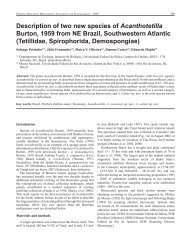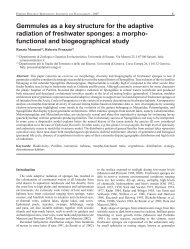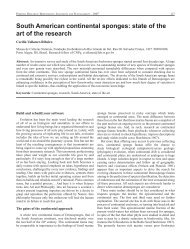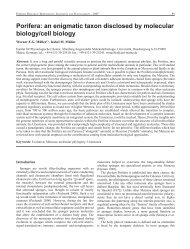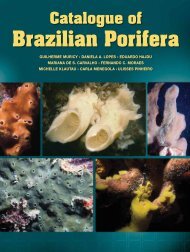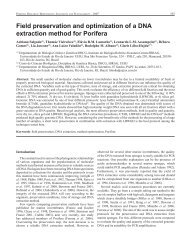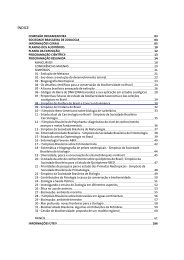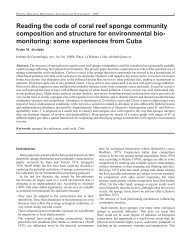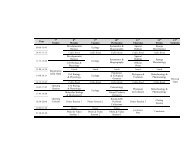Associations and interactions between gorgonians ... - Porifera Brasil
Associations and interactions between gorgonians ... - Porifera Brasil
Associations and interactions between gorgonians ... - Porifera Brasil
Create successful ePaper yourself
Turn your PDF publications into a flip-book with our unique Google optimized e-Paper software.
<strong>Porifera</strong> Research: Biodiversity, Innovation <strong>and</strong> Sustainability - 2007443<strong>Associations</strong> <strong>and</strong> <strong>interactions</strong> <strong>between</strong> <strong>gorgonians</strong><strong>and</strong> spongesElizabeth L. McLean (*) , Paul M. YoshiokaDepartment of Marine Sciences at the University of Puerto Rico – Mayagüez , PO Box 9013, Lajas, PR 00667-3264.elmclean@sbcglobal.net, p_yoshioka@cima.uprm.eduAbstract: The biodiversity of sessile marine invertebrates in coral reefs may be highly dependent upon associations <strong>and</strong><strong>interactions</strong> <strong>between</strong> species. In this study we describe the associations (i.e. physical contact <strong>between</strong> organisms) <strong>and</strong>subsequent <strong>interactions</strong> (e.g. competitive overgrowth, mutualistic effects) <strong>between</strong> sponges <strong>and</strong> <strong>gorgonians</strong> in La Parguera,southwest coast of Puerto Rico. Nearly half (15/32) of the sponge species were epibiotic on other sessile organisms. Thenumber of gorgonian colonies associated with sponges was positively correlated with the relative abundances of the gorgoniantaxa indicating that associations with sponges are generally r<strong>and</strong>om in nature. For instance, Pseudopterogorgia spp. wasthe most abundant gorgonian taxa <strong>and</strong> was the most often associated with sponges. Ecological <strong>interactions</strong> often involvedovergrowth of <strong>gorgonians</strong> including Pseudopterogorgia americana, Gorgonia ventalina <strong>and</strong> Pseudoplexaura spp. by spongessuch as Desmapsamma anchorata, Iotrochota birotulata, Dysidea janiae <strong>and</strong> Monanchora barbadensis. Of the 14 mostabundant gorgonian taxa, three were only mildly affected by sponges, <strong>and</strong> tissues of the remaining were killed by overgrowth.In contrast to negative effects, field observations suggest that Briareum asbestinum has mutualistic <strong>interactions</strong> with sponges.These results indicate that epibiotic associations may be a major factor for the high biodiversity of sponges in Caribbean reefs.As indicated by their relationships with <strong>gorgonians</strong>, these associations are largely r<strong>and</strong>om. However, <strong>interactions</strong> with theassociated organisms appear to be species-specific.Keywords: biodiversity, coral reef, <strong>gorgonians</strong>, sponges, species associationsIntroductionSpace on marine hard substratum is a limiting resourcefor numerous sessile organisms in coral reefs (Jackson 1977,Connell 1978) <strong>and</strong> is a major factor affecting biodiversity inthis habitat. Organisms growing in close proximity will oftencompete for suitable substrate by overgrowing, crowding,undercutting, digesting, overshadowing, or poisoning eachother (Bakus et al. 1986). These <strong>interactions</strong> can affect theorganization <strong>and</strong> function of reef communities (Buss <strong>and</strong>Jackson 1979, Wulff 2005). Stebbing (1973) <strong>and</strong> Wahle(1980) observed that competitive <strong>interactions</strong> that occuramong sessile organisms are often intense because of theirinability to change locations. These competitive <strong>interactions</strong>may be influenced by many factors including habitat conditionsas well as by competitive hierarchies or networks (Buss <strong>and</strong>Jackson 1979). In addition to negative (competitive) effects,<strong>interactions</strong> with scleractinian corals may have beneficial(mutualistic) effects by increasing coral survival (Goreau<strong>and</strong> Hartman 1963, Wulff <strong>and</strong> Buss 1979). Sponges may alsoenhance biodiversity by harbouring numerous invertebratespecies (Neves <strong>and</strong> Omena 2003, Ribeiro et al. 2003). Spongesalso clear up the water column, increase primary productivityby recycling nutrients <strong>and</strong> serve as food for other organisms(Reiswig 1971, Diaz <strong>and</strong> Rützler 2001, Wulff 2001).In this study we describe the associations <strong>and</strong> <strong>interactions</strong>of sponges with other sessile organisms with special attentionto the <strong>gorgonians</strong>. To avoid misunderst<strong>and</strong>ing, it should benoted that associations <strong>and</strong> <strong>interactions</strong> are not synonymous.<strong>Associations</strong> refer to the physical contact <strong>between</strong> sponges<strong>and</strong> <strong>gorgonians</strong>; whereas <strong>interactions</strong> refer to the post-contactecological outcome of the association.Interactions often involves overgrowth, defined here asthe elevation of the growing edge of one individual over theedge of another one (Stebbing 1973). Overgrowth generallyinvolves the death of the overgrown tissue although recoverycan occur in some instances (Buss <strong>and</strong> Jackson 1979, Russ1981). Specific overgrowth mechanisms include differentialgrowth rates (Buss <strong>and</strong> Jackson 1979, see also Lang 1973)<strong>and</strong> allelochemicals (Buss <strong>and</strong> Jackson 1979). Jackson <strong>and</strong>Buss (1975), Suchanek et al. (1983) <strong>and</strong> Aerts <strong>and</strong> van Soest(1996) suggest that these mechanisms are generally welldevelopedin sponges enabling them to outcompete corals forspace. Other <strong>interactions</strong> include st<strong>and</strong>off situations (Aerts2000), where growth of both organisms ceases at the contactboundary <strong>and</strong> intermingled growth which may benefit bothspecies by increasing structural support <strong>and</strong> predator defenses(eg., Wulff 1997).Materail <strong>and</strong> methodsThe study site is located at a depth of 6.7 m off of MediaLuna reef (17° 56.2’ N, 67° 3.2’W) in La Parguera, southwestcoast of Puerto Rico (see Yoshioka <strong>and</strong> Yoshioka 1989).
444This site has no emergent reefs, is characterized by a lowtopographic relief, <strong>and</strong> is exposed to wave action generatedby trade winds. Gorgonians are the visually dominant sessilemacroinvertebrate taxa at this study site.Sponges <strong>and</strong> their associations with <strong>gorgonians</strong> weresurveyed during December 2005 – February 2006 in a 1 x 20m belt transect. The nature of interaction <strong>between</strong> gorgonian<strong>and</strong> sponges (eg, overgrowth of the gorgonian) was inferredfrom five monitoring surveys <strong>between</strong> October 2003 – January2005 at approximately four month intervals. Gorgonians inthis transect have been monitored since 1983 (Yoshioka <strong>and</strong>Yoshioka 1989, Yoshioka 1998, 2005). To determine whetherassociations were positive, r<strong>and</strong>om or negative we comparedthe observed frequencies of sponge – gorgonian associationsto expected values based on the relative abundances ofgorgonian species. For instance, the association would bepositive if the observed frequency of a gorgonian speciesoccurring with sponges is greater than expected value basedon its relative abundance. Photographs were also taken forreference purposes.ResultsA total of 32 demosponge species were found in the studyarea. Of these, 18 (56%) were growing on other sessileorganisms (Table 1). The vast majority (15/18) of thesesponges were associated with <strong>gorgonians</strong>, probably because<strong>gorgonians</strong> constituted the greatest proportion of bioticsubstrate (at least in terms of their visual dominance) at thestudy site. Sponges were associated with 4.1% (71/1730) ofthe gorgonian colonies. Desmapsamma anchorata, Dysideajaniae, <strong>and</strong> Iotrochota birotulata were the sponges mostcommonly found on <strong>gorgonians</strong>. The associations <strong>between</strong>gorgonian <strong>and</strong> sponge species are given in Table 2. Gorgoniansmost commonly associated with sponges were also the mostabundant gorgonian taxa in the transesct: Pseudopterogorgiaspp., Pseudoplexaura spp., <strong>and</strong> Gorgonia ventalina.In terms of quantitative relationships, the proportions ofgorgonian colonies associated with sponges were significantlycorrelated (r 2 = 0.899, p < 0.01) with the relative abundancesof the gorgonian taxa (Fig. 1). The 95% CL of the regressionslope is not significantly different from 1.00 ( 0.72 – 1.02)indicating that proportions of sponge associated gorgonianTable 1: Sponge species <strong>and</strong> their substrates in the study area. Abiotic substrates include rock, rubble <strong>and</strong> sediment. Three additionalunidentified sponges (likely pertaining to order Dendroceratida <strong>and</strong> Order Halisarcida) were found only on abiotic substrates.SpeciesSubstrateAbiotic EpibioticCommentsAmphimedon compressa Duch. <strong>and</strong> Mich., 1864 yes yes On rocks, sediments, <strong>gorgonians</strong> <strong>and</strong> other spongesA. viridis Duch. <strong>and</strong> Mich., 1864 yes yes On rocks, sediments <strong>and</strong> <strong>gorgonians</strong>Cliona varians (Duch. <strong>and</strong> Mich., 1864) yes no On rocks <strong>and</strong> rubbleAplysina spp. Nardo, 1834 yes yes On rocks <strong>and</strong> <strong>gorgonians</strong>Artemisina melana Vosmaer, 1885 yes no On sedimentsCallyspongia vaginalis Lamarck, 1814 yes yes On rocks <strong>and</strong> <strong>gorgonians</strong>. Often with zoanthids <strong>and</strong> brittle stars onits surfaceC. plicifera Lamarck, 1814 yes no On rocks. Often with zoanthids <strong>and</strong> brittle stars on its surfaceChondrilla nucula Schmidt,1862 yes no On sediments <strong>and</strong> coral rubble. Often binds coral rubbleCinachyra spp. Sollas, 1886 yes no On sediments. Often covered with brown algae <strong>and</strong> s<strong>and</strong>Cliona delitrix Pang, 1974 yes yes Overgrows <strong>and</strong> bores dead/live corals. Often with zoanthids <strong>and</strong>brittle starsC. caribbaea (Langae) Carter, 1882 (Pang, 1973) yes yes Overgrows <strong>and</strong> bores dead/live corals <strong>and</strong> hydrocoralsDesmapsamma anchorata Carter, 1882 yes yes On rocks, sediments, buoy lines, <strong>gorgonians</strong>, hydrocorals, zoanthids<strong>and</strong> other sponges.Dysidea janiae Duch. <strong>and</strong> Mich., 1864 yes yes On <strong>gorgonians</strong> <strong>and</strong> very common on buoy linesEctyoplasia ferox Duch. <strong>and</strong> Mich., 1864 yes no On sediments, rocks <strong>and</strong> rubbleHaliclona implexiformis Hechtel, 1966 yes no On rocks <strong>and</strong> coral rubbleIotrochota birotulata Ridley, 1884 yes yes On sediments, rocks <strong>and</strong> <strong>gorgonians</strong>. Often with zoanthids <strong>and</strong>brittle stars on its surfaceIrcinia strobilina Lamarck, 1816 yes yes On sediments, rocks, rubble <strong>and</strong> <strong>gorgonians</strong>Monanchora barbadensis Hechtel, 1969 yes yes On coral rubble <strong>and</strong> <strong>gorgonians</strong>M. unguifera van Soest, 1984 yes yes On rocks, rubble <strong>and</strong> <strong>gorgonians</strong>Mycale laevis Carter, 1882 yes yes On numerous hard coral speciesM. carmigropila Hajdu <strong>and</strong> Rützler, 1998 yes yes On rocks <strong>and</strong> <strong>gorgonians</strong>M. laxissima Duch. <strong>and</strong> Mich., 1864 yes no On sediments, rocks <strong>and</strong> rubbleNeofibularia notilangere Duch. <strong>and</strong> Mich., 1864 yes no On sediments <strong>and</strong> dead coral. Harbors numerous invertebratesNiphates erecta Duch. <strong>and</strong> Mich., 1864 yes yes On sediments, <strong>gorgonians</strong> <strong>and</strong> other sponges. Often with zoanthids<strong>and</strong> brittle starsNiphates caycedoi (Zea <strong>and</strong> van Soest 1986) yes yes On sediments, rocks, rubble <strong>and</strong> <strong>gorgonians</strong>Plakortis spp. Schulze, 1880 yes no On sediments, rocks <strong>and</strong> rubbleScopalina ruetzleri Wiedenmeyer, 1977 yes yes On sediments, corals, <strong>gorgonians</strong>, hydrocorals <strong>and</strong> other spongesVerongula rigida Esper, 1794 yes no On sediments, rocks <strong>and</strong> rubbleXestospongia proxima Duch. <strong>and</strong> Mich., 1864 yes yes On sediments, rocks, rubble <strong>and</strong> <strong>gorgonians</strong>
Table 2: <strong>Associations</strong> of sponges <strong>and</strong> <strong>gorgonians</strong>. The values represent the number of observed incidences. See gorgonian taxa code givenin Fig. 1.445Sponge species Br Ecal Emam Esuc/ElaxGorgonian speciesGv Mur Mflv PflxPh/PhkPsx Pa Pte Plla Total %Amphimedon compressa 1 2 2 2 1 7 0.075Amphimedon erina 1 4 1 1 1 3 11 0.118Callyspongia vaginalis 1 0 0.000Chondrilla nucula 1 0 1 0.011Desmapsamma anchorata 9 5 4 1 2 3 5 20 0.215Dysidea janiae 1 1 2 26 30 0.323Iotrochota birotulata 3 7 1 6 1 1 1 3 9 8 6 43 0.462Ircinia strobilina 1 2 2 1 2 1 7 16 0.172Monanchora unguifera 1 1 1 1 8 3 15 0.161Mycale laevis 1 1Mycale laxisima 1 1 0 2 0.022Mycale carmigropila 1 0 0 0.000Niphates erecta 3 1 2 1 2 3 6 18 0.194Niphates caycedoi 1 0 1 0.011Scopalina ruetzleri 1 1 2 1 5 0.054Xestospongia proxima 2 2 0.022Total 14 18 2 18 11 2 4 12 15 21 67 1 3 171Fig. 1: Relative abundances (percentages) of colonies of gorgonian species versus the relative abundances associated with sponges. Gorgonianabundances derived from Yoshioka <strong>and</strong> Yoshioka (1989). Br = Briareum asbestinum was excluded from the regression analysis. Taxa code<strong>gorgonians</strong> in decreasing order of abundance are Pa = Pseudopterogorgia americana Gmelin, 1791 <strong>and</strong> Pseudopterogorgia acerosa Pallas,1766; Ecal = Eunicea calyculata Ellis <strong>and</strong> Sol<strong>and</strong>er, 1786 <strong>and</strong> E. tourneforti Milne Edwards <strong>and</strong> Haime, 1857; Psx = Pseudoplexaura spp.Houttuyn 1772; Esuc = Eunicea succinea Pallas, 1766, Elax = E. laxispica Lamarck, 1815; Gv = Gorgonia ventalina Linnaeus, 1758; Pflx= Plexaura flexuosa Lamouroux, 1821; Ph = Plexaura homomalla Esper, 1792. The less abundant unlabeled taxa in the figure include: Mur= Muricea elongata Lamouroux, 1821 - M. muricata Pallas, 1766; Mflv = Muriceopsis flavida Lamarck, 1815; Plla = Plexaurella spp.; Esp. 7 = Eunicea sp. 7, Emam = Eunicea mammosa Lamouroux, 1816; Elac = Eunicea laciniata Duchassaing <strong>and</strong> Michelotti, 1860; Efus =Eunicea fusca Duchassaing <strong>and</strong> Michelotti, 1860; E sp. 2 = Eunicea sp. 2; Pte = Pterogorgia anceps Pallas, 1766.
446species are equivalent to their relative abundances in thestudy site. This result indicates that the number of coloniesof the gorgonian species associated with sponges are mostlydetermined by the abundances of the gorgonian species.<strong>Associations</strong> <strong>between</strong> sponges <strong>and</strong> gorgonian species can bedescribed as r<strong>and</strong>om in this respect. A notable exception tothis overall r<strong>and</strong>om pattern was Briareum, which was foundhighly associated with sponges relative to its low abundance.Most <strong>interactions</strong> with sponges had negative effects on<strong>gorgonians</strong> as observed in the overgrowth (smothering) ofvarious gorgonian species by sponges such as Desmapsammaanchorata, Dysidea janiae <strong>and</strong> Iotrochota birotulata.Smothering could be ‘direct’ in the sense that the spongeadhered directly to the tissue/skeleton of the overgrownorganism (i.e., direct smothering, Fig. 2) or ‘indirect’ wherelethal or non lethal effects occurred without the adherenceof the sponge tissue (i.e., indirect smothering). These <strong>and</strong>other <strong>interactions</strong> are given in Table 3. These <strong>interactions</strong>were often species-specific. For instance, Desmapsammaanchorata usually outcompeted Pseudopterogorgia spp.by direct overgrowth but tissue discoloration of Gorgoniaventalina adjacent to the growing edge of Desmapsamma(Fig. 3) indicated the presence of allelochemicals.A notable exception to the negative <strong>interactions</strong>with <strong>gorgonians</strong> was observed <strong>between</strong> Briareum <strong>and</strong>Desmapsamma anchorata, Amphimedon compressa, <strong>and</strong>Mycale carmigropila. In these cases, Briareum <strong>and</strong> spongecolonies were intertwined <strong>and</strong> no indications of negative<strong>interactions</strong> were observed.DiscussionWe stress that the results of this study are preliminary inthe sense that future observations will increase the numberof sponges <strong>and</strong> associated species as well as species-specific<strong>interactions</strong>. Nevertheless, some general inferences can bemade about Caribbean sponges <strong>and</strong> the biodiversity of coralreefs. As in the case of tropical rainforests where the treecanopy accounts for much of the biodiversity, the gorgonian‘canopy’ serves as a habitat for many sponge species. Ourresults thus indicate that the high biodiversity of sponges ispartially attributable to their ability to circumvent substratespace limitation in coral reefs (Connell 1978) by growingepibiotically on other sessile organisms (Rützler 1970). Inturn, sponges harbor numerous invertebrate species (Neves<strong>and</strong> Omena 2003, Ribeiro et al. 2003).The associations <strong>and</strong> <strong>interactions</strong> of sponges with otherspecies also affect the biodiversity of sponges. Our resultssuggest that, with the exception of Briareum, the relativeabundance of gorgonian taxa largely determines theirassociations with sponges. This pattern represents a r<strong>and</strong>omassociation in the sense that the probability of a gorgoniancolony being associated with sponges is equal amongindividuals of all gorgonian species. In contrast to patternsof associations, <strong>interactions</strong> <strong>between</strong> sponges <strong>and</strong> <strong>gorgonians</strong>are often species-specific. Depending upon the speciesinvolved negative <strong>interactions</strong> may involve direct or indirectsmothering or allelochemicals. Also, in addition to negative<strong>interactions</strong>, the intertwined growth morphology observed<strong>between</strong> Briareum <strong>and</strong> various sponges may be indicativeFig. 2: Adherence of Dysidea janiae to Pseudoplexaura spp. Directsmothering of the tissue of Pseudoplexaura spp. caused by theovergrowing Dysidea janiae.Table 3: Sponges associated with <strong>gorgonians</strong> <strong>and</strong> their modes ofinteraction.SpeciesAmphimedon compressaAmphimedon erinaCallyspongia vaginalisDesmapsamma anchorataDysidea janiaeIotrochota birotulataIrcinia strobilinaMonanchora arbusculaMonanchora unguiferaMycale laevisMycale microsigmatosaNiphates erectaScopalina ruetzleriXestospongia caycedoiInteractionsovergrowth, smothering <strong>and</strong>intertwined growthsmotheringsmotheringovergrowth, smothering <strong>and</strong>intertwined growthovergrowth, smotheringovergrowth, smotheringovergrowth, smotheringovergrowthsmotheringsmotheringintertwined growthovergrowth, smotheringsmotheringsmothering
447Fig. 3: Overgrowth of a Gorgoniaventalina colony by Desmapsammaanchorata. A. May 2004; B.January 2005. Note the dying/dead tissue (arrow) in front of theDesmapsamma anchorata colonyindicating allelopathic effects.of a mutualistic interaction. Wulff (1997) documented thatintertwined growth of sponge species has mutualistic effects(see also Calcinai et al. 2004).Jackson (1977) suggests that the nature of <strong>interactions</strong>is related to various biological characteristics, such asdifferences in growth rates <strong>and</strong> morphologies of the sponge<strong>and</strong> associated organism. The inferred allelochemical effectsof Desmapsamma anchorata on Gorgonia ventalina areconsistent with the observations of Buss <strong>and</strong> Jackson (1979).Combined with possible mutualistic effects of Desmapsammaanchorata with Briareum <strong>and</strong> negative (overgrowth)<strong>interactions</strong> with other <strong>gorgonians</strong>, these results indicate thatvariations in species-specific <strong>interactions</strong> may be a majorfactor underlying the high biodiversity of coral reef systems.AcknowledgementsWe are grateful to Sven Zea for his assistance on the identificationof sponge species <strong>and</strong> to Klaus Rützler for revision <strong>and</strong> providinginsights on the manuscript. We thank E. Rodriguez, C. Prada, <strong>and</strong> A.Mercado for their assistance in the field, the staff of the Departmentof Marine Sciences of the University of Puerto Rico Mayagüez forall their help <strong>and</strong> support. Funding was provided by NOAA – CRESprogram (NA 17OP2919).ReferencesAerts LAM (2000) Dynamics behind st<strong>and</strong>off <strong>interactions</strong> in threereef sponge species <strong>and</strong> the coral Montastraea cavernosa. MarEcol 21: 191-204Aerts LAM, van Soest RWM (1996) Quantification of sponge/coral<strong>interactions</strong> in a physically stressed reef community, NE Colombia.Mar Ecol Progr Ser 148: 125-134Bakus GJ, Targett NM, Schulte B (1986) Chemical ecology ofmarine organisms: an overview. J Chem Ecol 12: 951-987Buss LW, Jackson JBC (1979) Competitive networks: nontransitivecompetitive relationships in cryptic coral reef environment. AmNat 113: 223-234Calcinai B, Bavestrello G, Cerrano C (2004) Dispersal <strong>and</strong>association of two alies species in the Indonesian coral reefs:the octocoral Carijoa riisei <strong>and</strong> the demosponge Desmapsammaanchorata. J Mar Biol Assoc UK 84: 937-941
448Connell JH (1978) Diversity in tropical rain forest <strong>and</strong> coral reefs.Science 199: 1302-1309Diaz MC, Rützler K (2001) Sponges: an essential component ofCaribbean Coral Reefs. Bull Mar Sci 69(2): 535-546Goreau TF, Hartman WD (1963) Boring sponges as controllingfactors in the formation <strong>and</strong> maintenance of coral reefs. Am AssocAdv Sci Publ 75: 25-54Jackson JBC (1977) Competition on marine hard substrata: theadaptive significance of solitary <strong>and</strong> colonial strategies. Am Nat111: 743-767Jackson JBC, Buss LW (1975) Allelopathy <strong>and</strong> spatial competitionamong coral reef invertebrates. Proc Nat Acad Sci USA 72: 5160-5163Lang JC (1973) Interspecific aggression by scleractinian corals. II.Why the race is not only to the swift. Bull Mar Sci 23: 260-279Neves G, Omena E (2003) Influence of sponge morphology on thecomposition of the polychaete associated fauna from Rocas Atoll,northeast Brazil. Coral Reefs 22: 123-129Reiswig HM (1971) In situ pumping activity of tropicaldemospongiae. Mar Biol 9: 38-50Ribero S, Omena E, Muricy G (2003) Macrofauna associated toMycale microsigmatosa (<strong>Porifera</strong>, Demospongiae) in Rio deJaneiro State, SE Brazil. Estuar Coast Shelf Sci 57: 951-959Russ GR (1981) Effects of predation by fishes, competition <strong>and</strong>structural complexity if substrates on establishment of a marineepifaunal community. J Exp Mar Biol Ecol 42: 55-69Rützler K (1970) Spatial competition among <strong>Porifera</strong>: solution byepizoism. Oecologia (Berlin) 5: 85-95Stebbing ARD (1973) Competition for space <strong>between</strong> epiphytes ofFucus serratus L. J Mar Biol Assoc UK 53: 247-261Suchanek TH, Carpenter RC, Witman JD, Harvell CD (1983)Sponges as important space competitors in the deep Caribbeancoral reef communities. Contr W Indies Lab Symp Ser 109: 55-60Wahle CM (1980) Detection, pursuit, <strong>and</strong> overgrowth of tropical<strong>gorgonians</strong> by milleporid hydrocorals: Perseus <strong>and</strong> Medusarevisited. Science 209: 689-691Wulff JL (1997) Mutualism among species of coral reef sponges.Ecology 78: 146-159Wulff JL (2005) Trade-offs in resistance to competitors <strong>and</strong> predators,<strong>and</strong> their effects on the diversity of tropical marine sponges. J AnimEcol 74: 313-321Wulff JL, Buss LW (1979) Do sponges help hold coral reefs together?Nature 281: 474-475Yoshioka PM (1998) Are large colonies a “key factor” in thedynamics of gorgonian populations? Rev Biol Trop 46: 137-143Yoshioka PM (2005) Biotic neighborhoods of shallow water<strong>gorgonians</strong> of Puerto Rico. Bull Mar Sci 76:625-636Yoshioka PM, Yoshioka B (1989) A multispecies, multiscale analysisof spatial pattern <strong>and</strong> its application to shallow-water gorgoniancommunity. Mar Ecol Progr Ser 54: 257-264



